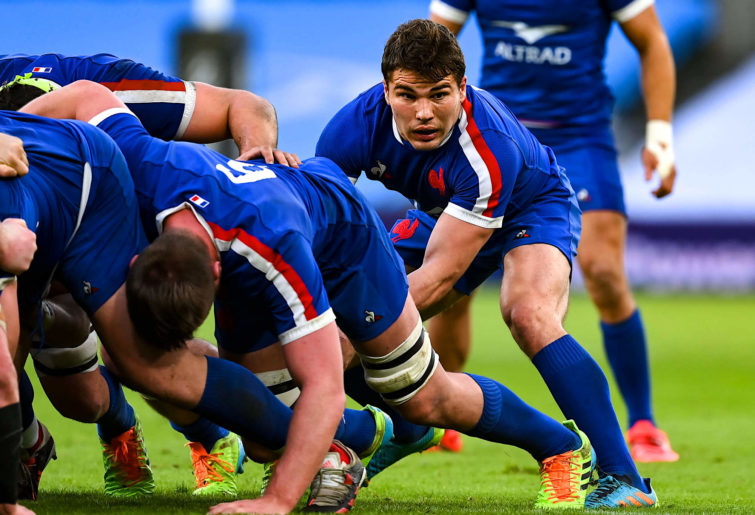France and Ireland contested the Six Nations this year. It came down to one score between them on a dark night in Paris with the Irish missing their most experienced leader. A kick to the corner instead of taking the three and who knows? Not much separated the Grand Slam and the Triple Crown winner this go around.
Except their statistics and style!
A world apart, they were.
Ireland ran with the ball for 4569 metres; France, 2955. First in the competition and last.
Fullback Hugo Keenan ran the most metres for Ireland (389), followed by Aussie transplant Mack Hansen (329), Josh van der Flier (267) and Caelan Doris (289). Gregory Alldritt was the top metre gainer for France (318), followed by Gabin Villiere (261).
But kicking? Reversed. France kicked the most distance (5423m) and Ireland the least (3457).
Antoine Dupont is feted for his running game and well he can be, but he lapped the field in kick meters (1930m). His teammates Romain Ntamack (1347m) and Melvyn Jaminet (1265m) also kicked more distance than the top metre-gaining Irish kicker, Jamison Gibson-Park (933m).
The Irish carried the most times in the tournament (694 carries), almost a hundred more times than France (496 carries). Once again, Ireland led the field in handling the ball (1702 times) and France lagged everyone (1014 handlings of the ball).
JGP touched the ball 412 times. Dupont trailed him (264 times). Similarly, Johnny Sexton outhandled Ntamack (142-92) despite missing a match.

Antoine Dupont (Photo By Brendan Moran/Sportsfile via Getty Images)
Passing? Ireland passed 1047 times and France only 568. However, France led the comp in offloads (50), with Ireland third (39). Cyril Baille, the ‘prop-half’, tied with Dupont for offloads completed (eight each). Alldritt (seven) was on par with Hansen (seven) and nipped Sexton (five).
This translates into the French offloading on ten per cent of their carries; Ireland on 5.6 per cent, a real stylistic difference.
Both score tries on about 3.4 to 3.5 per cent of their carries, but with the Irish carrying so many more times, they scored seven more tries than the French (24-17). In their head-to-head meeting, Ireland scored more tries, too.
The two sides were about the same in breaking tackles (Ireland second, France third), with wing Damian Penaud (13) and Dupont (13) prominent. Garry Ringrose (11 broken tackles) was the Irish buster.
Alldritt was the heavy carrier in the competition (65 carries), whilst Ringrose (55), Keenan (47), Taidgh Beirne (45), van der Flier (44), Dan Sheehan (44), Caelan (43), and Lowe (39) shared the Irish carrying duties with great equality. The second highest carrier for France was Jaminet at 40.
If some of the same names keep coming up, there were three players who were on the field for all 400 minutes: Ntamack, Gael Fickou, and van der Flier.
France was not as good as Ireland in taking care of the passed ball: they had handling errors on 12 per cent of carries, compared to Ireland’s 7.8 per cent, a significant difference.
But France jarred the ball loose from their opponents better, with 5.4 per cent of their tackles ‘dominant’, compared to 2.9 per cent of Irish tackles.
Paul Willemse had seven dominant tackles alone (he missed eight, too).
Busiest tacklers were loose forwards, of course: Anthony Jelonch (64), Francois Cros (58) and Alldritt (53) were a match for van der Flier (58) and Doris (53). Cros had four dominant tackles, and in the end, his type of tackling helped France win 33 turnovers (to Ireland’s 19) and concede 26 fewer turnovers, too.
Players like Alldritt (six turnovers won; six penalties conceded), Beirne (5-5), Doris (4-4), and Jelonch (4-4) were tidy on the ground, but Doris did concede too many turnovers (seven). Stu Hogg was the leader in this stat: eight.
Speaking of bad stats: Ntamack missed 11 tackles (the worst in the comp). Ringrose and Alldritt missed seven each.
But overall, the teams missed about the same rate of tackles: ten per cent or so, the best in the Six Nations.
France broke more tackles per carry (17.5 per cent of their carries led to a tackle bust versus 14.1 per cent for Ireland), but Ireland carried so many more times.
The scrum was a liability for Ireland in this tournament, which is ominous for the World Cup when they play South Africa, and likely, France.
Twenty-six per cent of Irish penalties were for scrummaging issues. They had 13 scrum penalties to France’s four.
But the most equal statistic of all? Cards. Both had zero.
All of this to show rugby remains a sport that is not monolithic. The two top teams played diametrically opposed patterns. Yet they had clarity.
The three teams with only two wins and a disappointing campaign (England, Wales, and Scotland) seemed betwixt and between styles, in search of an overarching game plan.
The Irish setup takes a lot of energy, leaner forwards, on-time cleaners, and a lively 9. They won a bonus point from every match, and fell short in Paris without their on-field coach. France relies more on territory and power, daring teams to take them on at the gainline. They have depth at just about every position, which the Irish do not (second row, 10).
The numbers which may end up mattering most for next year could possibly be players 16-33 rather than 1-15. Depth is king.





























































































